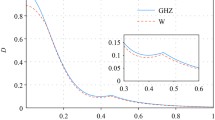Abstract
Using an imperfectly prepared state, we show that in relativistic settings, the evolution of a massive spin-1/2 particle violates many standard assumptions made in quantum information theory, including complete positivity. Unlike other recent endeavors in relativistic quantum information, we are able to quantify and maximize how much information can be transferred through such a quantum process by calculating its scope. We show that, surprisingly, relativistic noise can increase the amount of information that can be transferred, and in fact, even if the initial state is arbitrarily close to the completely mixed state, information can still be transferred perfectly. Additionally, we explore the relativistic effects of velocity and gravity on quantum information processing, and we briefly discuss how quantum computation is affected by general relativity. In particular, we show that the large Wigner rotation caused by a black hole as described in the Schwarzchild metric can greatly increase the informatic content of a qubit.










Similar content being viewed by others
References
Alsing PM, Stephenson GJ, Kilian P (2009) Spin-induced non-geodesic motion, gyroscopic precession, Wigner rotation and EPR correlations of massive spin-\(\frac{1}{2}\) particles in a gravitational field. arXiv:0902.1396v1 [quant-ph]
Bauke H et al (2014) Relativistic spin operators in various electromagnetic environments. Phys Rev A 89:052101
Breuer H-P, Petruccione F (2002) The theory of open quantum systems. Oxford University Press, New York
Céleri LC, Kiosses V, Terno DR (2016) Spin and localization of relativistic fermions and uncertainty relations. Phys Rev A 94:062115
Choi MD (1975) Completely positive linear maps on complex matrices. Linear Algebra Appl 10:285–290
Choi T (2013) Relativistic spin operator and Lorentz transformation of the spin state of a massive Dirac particle. J Korean Phys Soc 62:1085–1092
Cover T, Thomas J (2006) Elements of information theory. Wiley, Hoboken, NJ
Crowder T (2013) Representations of quantum channels. Dissertation, Howard University
Crowder T (2011) A quantum representation for involution groups. Electron Notes Theor Comput Sci 276:145–158
Crowder T (2015) A linearization of quantum channels. J Geom Phys 92:157–166
Crowder T, Martin K (2011) Classical representations of qubit channels. Electron Notes Theor Comp Sci 270:37–58
Crowder T, Martin K (2012) Information theoretic representations of qubit channels. Found Phys 42:976–983
Crowder T, Lanzagorta M (2018) The scope of a relativistic quantum process with spin-momentum entanglement. In: Stepney S, Verlan S (eds) Unconventional computation and natural computation. Lecture Notes in Computer Science, vol 10867. UCNC, 2018
Fitzsimons J (2017) Private quantum computation: an introduction to blind quantum computing and related protocols. NPJ Quantum Inf 3:23
Fuchs CA, van de Graaf J (1999) Cryptographic distinguishability measures for quantum-mechanical states. IEEE Trans Inf Theory 45:1216–1227
Gingrich RM, Adami C (2002) Quantum entanglement of moving bodies. Phys Rev Lett 89:270402
Lanzagorta M (2013) Quantum information in gravitational fields. Institute of Physics, San Rafael, CA
Lanzagorta M, Crowder T (2017) Comment on “Wigner rotations and an apparent paradox in relativistic quantum information”. Phys Rev A 96:026101
Lanzagorta M, Salgado M (2016) Detection of gravitational frame dragging using orbiting qubits. Class Quantum Gravity 33:105013
Lanzagorta M, Uhlmann J (2019) Theoretical foundations for design of a quantum Wigner interferometer. IEEE J Quantum Electron 55:8700207
Lanzagorta M, Jitrik O, Uhlmann J, Venegas-Andraca SE (2017) Data fusion in entangled networks of quantum sensors. Proc SPIE 10200:102000M
Lanzagorta M, Uhlmann J (2016) Quantum computational complexity in curved spacetime. In: Burgin M, Calude C (eds) Information and complexity, pp 227–248. World Scientific
Lanzagorta M, Uhlmann J, Venegas-Andraca SE (2015) Quantum sensing in the maritime environment. In: Proceedings of the IEEE/MTS oceans conference
Martin K (2008) The scope of a quantum channel. Proc Symp Appl Math 71:183–211
Martin K, Crowder T, Feng J (2015) Quantum error reduction without coding. In: Proceedings radar sensor technology XIX; and active and passive signatures VI, vol 9461, p 946114
Nielsen M, Chuang IL (2000) Quantum computation and quantum information. Cambridge University Press, Cambridge
Peres A, Terno DR (2002) Relativistic Doppler effect in quantum communication. J Mod Opt 50:1165–1173
Peres A, Scudo PF, Terno DR (2002) Quantum entropy and special relativity. Phys Rev Lett 88:230402
Saldanha P, Vedral V (2012) Physical interpretation of the Wigner rotations and its implications for relativistic quantum information. New J Phys 14:023041
Taillebois ERF, Avelar AT (2013) Spin-reduced density matrices for relativistic particles. Phys Rev A 88:060302
Terashima P, Ueda M (2004) Einstein–Rosen correlation in gravitational field. Phys Rev A 69:032113
Weinberg S (1995) The quantum theory of fields. Cambridge University Press, New York
Acknowledgements
We are grateful to K. Martin and D. Terno for their helpful discussions during the preparation of this manuscript. In particular, we are thankful for the insightful discussions with Keye Martin about radiative processes of charged particles in the accretion disk of a black hole. We are also grateful to the organizers of the 17th conference on Unconventional Computation and Natural Computation, Serghei Verlan and Susan Stepney, where a truncated version of this paper was presented. We received great feedback that helped shape this extended version. In particular, we would like to thank Susan Stepney for displaying interest in the far-fetched idea of relativistic steganographic quantum communication. That discussion helped inspire the section on kinematic noise.
Author information
Authors and Affiliations
Corresponding author
Additional information
Publisher’s Note
Springer Nature remains neutral with regard to jurisdictional claims in published maps and institutional affiliations.
Rights and permissions
About this article
Cite this article
Crowder, T., Lanzagorta, M. Quantum information processing in the neighborhood of a black hole. Nat Comput 18, 549–561 (2019). https://doi.org/10.1007/s11047-019-09737-7
Published:
Issue Date:
DOI: https://doi.org/10.1007/s11047-019-09737-7




